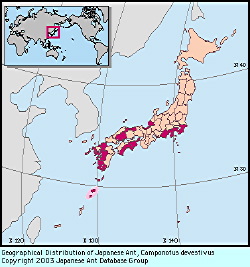
|
species
|
Camponotus devestivus
|
 |
Japanese Name
|
Ameiro-oo-ari
|
Original Reference
|
|
Wheeler, W.M. (1928) Ants collected by Professor F. Silvestri in Japan and Korea. Bollettino del Laboratorio di Zoologia generale e agraria del R. Istituto Superiore agrario di Portici 22: 96-125.
|
Description
|
|
Total length of workers around 7 - 10 mm. Head brown to dark brown; mesosoma, petiole and legs yellowish brown; gaster brown to blackish brown. Head long. Clypeus apically truncated. Mandibles each with 6 teeth. Scapes long, more than 1.8 times head width in minor workers, exceeding posterior margin of head by 1/4 their length in major workers. Petiolar scale thick and triangular in profile. Pronotum without erect hairs; mesonotum with only one pair of erect hairs; fewer than 3 hairs on anterior coxae.
|
Remarks
|
|
This species nests in tree trunks or dead twigs. Three worker subcastes are recognized (Harada, 1993, 1996).
|
|

Distribution
|
|
Honshu (Kanto District and southwards), Shikoku, Kyushu, Yaku I., Ryukyu Is (Tokunoshima I. and northwards).
|
|
References
|
|
- Wheeler, W. M. (1928). Ants collected by Professor F. Silvestri in Japan and Korea. . Boll. Lab. Zool. Gen. Agrar. Portici, 21, 96-125.
- Harada, Y. (1996). Division of labor of subcast of Japanese formicine ant, camponotus devestivus (Hymenoptera, Formicidae). Nankiseibutu 38: 57-63. (In Japanese.)
- Harada, Y. (1993). Life cycle of Japanese formicine ants, Camponotus devestivus (Hymenoptera, Formicidae). Nankiseibutu 35: 111-116.
|
Editor
|
|
Original text by Mamoru Terayama, Masaaki Morisita and Keiichi Onoyama. English translation by Mamoru Terayama, edited by Robert W. Taylor.
|
|